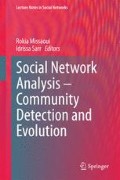Abstract
Online dating sites have become popular platforms for people to look for romantic partners, providing an unprecedented level of access to potential dates that is otherwise not available through traditional means. Characterization of the user online dating behavior helps us to obtain a deep understanding of their dating preference and make better recommendations on potential dates. In this paper we study the user online dating behavior and preference using a large real-world dataset from a major online dating site in China. In particular, we characterize the temporal behavior, message send and reply behavior of users, study how users online dating behaviors correlate with various user attributes, and investigate how users’ actual online dating behaviors deviate from their stated preferences. Our results show that on average a male sends out more messages but receives fewer messages than a female. A female is more likely to be contacted but less likely to reply to a message than a male. The number of messages that a user sends out and receives per week quickly decreases with time, especially for female users. Most messages are replied to within a short time frame with a median delay of around 9 h. Many of the user messaging behaviors align with notions in social and evolutionary psychology: males tend to look for younger females while females place more emphasis on the socioeconomic status (e.g., income, education level) of a potential date. The geographic distance between two users and the photo count of users play an important role in their dating behavior. We show that it is important to differentiate between users’ true preferences and random selection. Some user behaviors in choosing attributes in a potential date may largely be a result of random selection. We also find that while both males and females are more likely to reply to users whose attributes come closest to the stated preferences of the receivers, there is significant discrepancy between a user’s stated dating preference and his/her actual online dating behavior. We further characterize how users actual dating behavior deviate from their stated preference. These results can provide valuable guidelines to the design of a recommendation engine for potential dates.
Access this chapter
Tax calculation will be finalised at checkout
Purchases are for personal use only
References
Buss DM (1989) Sex difference in human mate preferences: evolutionary hypotheses tested in 37 cultures. Behav Brain Sci 12:1–49
Cai X, Bain M, Krzywicki A, Wobckes W, Kim YS, Compton P, Mahidadia A (2011) Collaborative filetering for people to people recommendation in social networks. Adv Artif Intell 476–485
Eagly AH, Wood W (1999) The origin of sex differences in human behavior: evolved dispositions versus social roles. Am Psychol 54:408–423
Eastwick PW, Finkel EJ (2008) Sex difference in mate preferences revisited: do people know what they initially desire in a romantic partner? J Pers Soc Psychol 94:245–264
Finkel EJ, Eastwick PW, Karney BR, Reis HT, Sprecher S (2012) Online dating: a critical analysis from the perspective of psychological science. Psychol Sci Public Interest 3:3–66
Fiore AT, Taylor LS, Zhong X, Mendelsohn GA, Cheshire C (2010) Who’s right and who writes: people, profiles, contacts, and replies in online dating. In: Proceedings of Hawaii international conference on system sciences
He Q, Zhang Z, Zhang J, Wang Z, Tu Y, Ji T, Yi T (2013) Potentials-attract or likes-attract in human mate choice in china. PLoS ONE 8(4):e59457
Hitsch GJ, Hortacsu A, Ariley D (2010) Matching and sorting in online dating. Am Econ Rev 100:130–163
Hitsch G, Hortasu A, Ariely D (2010) What makes you click? Mate preferences in online dating. Quant Mark Econ 8:393–427
Li l, Li T (2010) MEET: a generalized framework for reciprocal recommender systems. In: Proceedings of ACM international conference on information and knowledge management
Lin K-H, Lundquist J Mate selection in cyberspace: the intersection of race, gender, and education. Am J Sociol (forthcoming)
Luo S, Klohnen EC (2005) Assortative mating and marital quality in newlyweds: a couple-centered approach. J Pers Soc Psychol 88:304–326
Match.com, Bailey CM (2010) Recent trends: online dating
OkTrends. http://www.okcupid.com
Online dating statistics. http://www.statisticbrain.com/online-dating-statistics/
Pizzato L, Rej T, Chung T, Koprinska I, Kay J (2010) RECON: a reciprocal recommender for online dating. In: Proceedings of ACM conference on recommendation system
Slater D (2013) Love in the time of algorithm. Penguin Group, New York
Tu K, Ribeiro B, Jensen D, Towsley D, Liu B, Jiang H, Wang X (2014) Online dating recommendations: matching markets and learning preferences. In: Proceedings of 5th international workshop on social recommender systems, in conjunction with 23rd international world wide web conference
Xia P, Jiang H, Wang X, Chen C, Liu B (2014) Predicting user replying behavior on a large online dating site. In: Proceedings of 8th international AAAI conference on weblogs and social media
Xia P, Ribeiro B, Chen C, Liu B, Towsley D (2013) A study of user behaviors on an online dating site. In: Proceedings of the IEEE/ACM international conference on advances in social networks analysis and mining
Zhao K, Wang X, Yu M, Gao B (2014) User recommendation in reciprocal and bipartite social networks—a case study of online dating. In: Proceedings of intelligent systems. IEEE
Acknowledgments
This work was supported by the NSF grant CNS-1065133 and ARL Cooperative Agreement W911NF-09-2-0053. The views and conclusions contained in this document are those of the authors and should not be interpreted as representing the official policies, either expressed or implied of the NSF, ARL, or the US Government.
Author information
Authors and Affiliations
Corresponding author
Editor information
Editors and Affiliations
Rights and permissions
Copyright information
© 2014 Springer International Publishing Switzerland
About this chapter
Cite this chapter
Xia, P. et al. (2014). Characterization of User Online Dating Behavior and Preference on a Large Online Dating Site. In: Missaoui, R., Sarr, I. (eds) Social Network Analysis - Community Detection and Evolution. Lecture Notes in Social Networks. Springer, Cham. https://doi.org/10.1007/978-3-319-12188-8_9
Download citation
DOI: https://doi.org/10.1007/978-3-319-12188-8_9
Published:
Publisher Name: Springer, Cham
Print ISBN: 978-3-319-12187-1
Online ISBN: 978-3-319-12188-8
eBook Packages: Computer ScienceComputer Science (R0)

